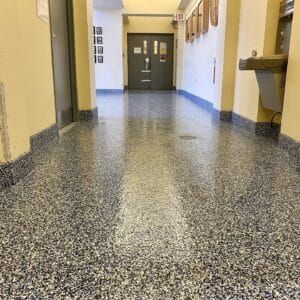Urethane Floor Coating: What You Need to Know
If you’re an environmentally-conscious architect or builder diving into durable, cost-effective, and eco-friendly flooring solutions, urethane floor coating might just be the hero you’re looking for. Here’s the quick scoop:
- Durability: It stands up to wear and tear like a champion.
- Versatility: Perfect for concrete, hardwood, and over existing coatings.
- Aesthetics: Keeps floors looking glossy or satin-smooth, with clear or pigmented options.
- Environmental Consideration: Offers a more eco-friendly option with long-lasting results, minimizing the need for frequent replacements.
Urethane floor coatings are a powerhouse in the flooring industry, offering exceptional protective qualities that not only extend the life of floors but also enhance their visual appeal. This makes it an excellent choice for architects and builders striving to fulfill both the sustainability demands and aesthetic desires of their clients. With benefits like incredible durability against foot and wheeled traffic, resistance to chemicals, and the ability to maintain a fresh look for years, urethane coatings are leading the way in sustainable building practices. Whether you’re covering a well-loved hardwood floor or sealing a high-traffic concrete area, urethane coatings provide a versatile and reliable solution.
For those navigating the complexities of green building certifications, understanding how urethane floor coatings can contribute to your goals is vital. Not only do they offer a long lifespan—reducing the environmental impact associated with frequent renovations—they also support healthier indoor air quality by resisting moisture and mold growth.
To make this digestible, let’s look at an infographic that breaks down the merits of choosing urethane coating for your next project:

In this brief intro, we’ve only scratched the surface. But for those invested in marrying client satisfaction with sustainability, urethane floor coatings offer a promising path forward.
Understanding Urethane Floor Coatings
When you dive into urethane floor coatings, you’re entering a realm where durability, chemical resistance, and innovative chemistry meet. Let’s break down some key components that make urethane coatings a top choice for protecting and enhancing floors.
Polyaspartic Esters: The Science Behind the Strength
At the heart of many urethane coatings lies a relatively new but mighty player: polyaspartic esters. These chemical compounds, introduced in the early 1990s, have revolutionized the coatings industry with their quick-drying properties and robust performance. What makes them stand out is their ability to form a protective layer that is both incredibly strong and flexible. This balance is crucial for floors that see a lot of action, whether it’s the constant foot traffic in a busy hospital or the heavy machinery rolling through a manufacturing plant.
Polyaspartic esters are known for their excellent adhesion and wear resistance, making them an ideal choice for areas that demand high performance .
Chemical Resistance: A Barrier Against Spills and Stains
One of the most compelling reasons to choose a urethane coating is its resistance to chemicals. Whether it’s an accidental spill in a laboratory or the harsh cleaning agents used in industrial settings, urethane floor coatings hold their ground. They prevent these substances from penetrating and damaging the floor, ensuring that your investment remains intact for years to come.
Durability: Built to Last
The durability of urethane coatings is nothing short of impressive. These coatings are designed to withstand everything from the scuffing feet of a thousand shoppers to the relentless grinding of heavy machinery. This resilience is partly due to the coatings’ ability to flex slightly under pressure, absorbing impacts without cracking or chipping.
It’s this combination of flexibility and strength that allows urethane coatings to endure the test of time, often lasting a decade or more before needing a touch-up. This longevity isn’t just good for your budget; it’s also beneficial for the environment, reducing the need for frequent resurfacing or replacement.
In Summary:
Urethane floor coatings, with their polyaspartic esters backbone, provide a solution that’s tough against wear and tear, resistant to chemicals, and durable enough to last for years. Whether you’re outfitting a new facility or upgrading an existing space, understanding these key aspects of urethane coatings can help you make an informed decision that meets your needs.
Next, we’ll explore how urethane stands up against epoxy coatings and why one might be a better fit for your project than the other. Stay tuned as we delve deeper into floor coatings, ensuring you have all the information you need to choose the best protection for your floors.

Epoxy vs. Urethane Floor Coatings
When deciding between epoxy and urethane floor coatings, weigh their benefits and differences to determine which is best for your specific needs. Let’s break down what each offers and where one might edge out the other.
Epoxy Benefits:
- Durability: Epoxy is incredibly strong and can handle a lot of wear and tear, making it ideal for high-traffic areas.
- Chemical Resistance: It resists damage from many chemicals, perfect for labs or industrial settings.
- Aesthetic Options: With epoxy, you have a wide range of colors and patterns to choose from, allowing for customization.
- Cost-Effective: Generally, epoxy is less expensive upfront compared to urethane coatings.
Urethane Advantages:
- Flexibility: Urethane coatings retain more flexibility, making them less prone to cracking under stress.
- Moisture Resistance: These coatings offer superior protection against moisture, which is crucial in damp environments or where spills are frequent.
- Thermal Shock Resistance: Urethane withstands extreme temperature changes without damage, ideal for areas subjected to hot washdowns or cold storage.
- UV Resistance: If your flooring is exposed to sunlight, urethane won’t yellow or fade over time, unlike some epoxies.
Application Differences:
- Preparation: Epoxy may require more extensive floor preparation to ensure proper adhesion. Urethane, while also needing a clean surface, is less finicky about the prep work.
- Application: Epoxy is typically applied in thicker layers than urethane. Urethane, being thinner, is often used as a topcoat over epoxy for added protection.
Choosing Between the Two:
- For Heavy Industrial Use: Epoxy might be your go-to for its robustness and chemical resistance.
- For Areas with Moisture and Temperature Extremes: Urethane is likely the better choice due to its superior moisture resistance and flexibility.
In conclusion, while both epoxy and urethane floor coatings offer significant benefits, the right choice depends on the specific demands of your flooring area. Epoxy provides a strong, durable, and chemically resistant surface with lots of design flexibility. In contrast, urethane adds unparalleled moisture resistance, flexibility, and protection against thermal shocks and UV rays.
Considering these factors will guide you in selecting a floor coating that not only looks great but also stands up to the challenges of your unique environment. Don’t forget, for areas facing a combination of challenges, applying urethane over an epoxy base might just offer the best of both worlds.
As we move into the next section on How to Apply Urethane Floor Coatings, keep these comparisons in mind to ensure you’re choosing the most appropriate coating for your needs.
How to Apply Urethane Floor Coatings
Applying a urethane floor coating is not just about brushing it on and hoping for the best. It’s a thoughtful process that, when done correctly, can transform any floor into a durable, glossy masterpiece that stands the test of time. Here, we’ll break down the steps and tips to make this task as straightforward as possible.
Preparation is Key
Before you even open a can of urethane, the surface needs to be ready. This means:
- Cleaning: Ensure the floor is free of dust, dirt, and oils. A clean surface allows the urethane to adhere properly.
- Repairs: Fix any cracks or chips in the flooring. Urethane is tough, but it’s not a magic fix for existing damage.
- Sanding: For certain surfaces, a light sanding helps the urethane to grip the floor.
Choosing Your Application Method
There are a few ways to apply urethane, each with its own set of advantages.
- Brush Application: Good for small areas or where precision is needed. It can be slow and requires a steady hand.
- Wipe-Up Formula: Ideal for applying urethane to vertical surfaces without drips or sags.
- Spray Finishes: The fastest method for large areas. It requires specialized equipment and a bit more skill to ensure even coverage.
Installation Tips
- Thin Coats: It’s tempting to slather on a thick layer of urethane for protection. Resist this urge. Thin, even coats dry faster and reduce the risk of bubbles and imperfections.
- Drying Time: Patience is a virtue. Allow each coat to dry completely before applying the next. This could take anywhere from a few hours to overnight, depending on the product and conditions .
- Ventilation: Urethane can produce strong fumes. Keep your workspace well-ventilated to avoid breathing in harmful chemicals.
- Safety Gear: Gloves, goggles, and masks are your friends. Protect yourself from chemicals and fumes.
Final Thoughts
The goal is to achieve a durable, beautiful finish that will protect your floor for years to come. Take your time, follow the steps, and don’t cut corners. A well-applied urethane floor coating not only looks fantastic but also offers unparalleled protection against wear and tear.
For areas facing a combination of challenges, applying urethane over an epoxy base might just offer the best of both worlds. As we transition into the next section, keep these application tips in mind to ensure your urethane floor coating project is a success.
Choosing the Right Urethane Floor Coating for Your Needs
When it comes to picking the perfect urethane floor coating, it’s not just about choosing a color or finish. You’re making a decision that impacts the durability, maintenance, and overall functionality of your space. Let’s break down the key factors you should consider:
Self-priming Options
Some urethane coatings are self-priming. This means you might not need to apply a separate primer before the main coating. It saves time and effort, especially in environments where downtime needs to be minimized.
High Compressive Strength
Urethane coatings are known for their high compressive strength. This is the coating’s ability to withstand loads without cracking. In places with heavy machinery or equipment, this feature is non-negotiable.
Impact Resistance
Whether it’s a dropped tool in a workshop or high foot traffic in a commercial space, your floor needs to handle impact without showing every mark. Urethane floor coatings offer excellent impact resistance, keeping your floors looking new for longer.
Moisture Vapor Transmission
Some areas are prone to moisture, which can be a nightmare for flooring. Urethane coatings with high moisture vapor transmission resistance can prevent moisture from causing damage or lifting the coating. This is critical in basements, kitchens, or any area where moisture is a concern.
Performance Topcoat Options
Not all urethane coatings are created equal. Some come with performance topcoat options that offer additional benefits, such as increased chemical resistance or anti-slip properties. Depending on your specific needs, these topcoats can provide an extra layer of protection.
Poly-Crete
Poly-Crete is a specific type of urethane coating known for its robust properties, including resistance to thermal shock, chemicals, and wear. It’s particularly suited for environments with extreme conditions, such as kitchens, industrial facilities, and areas with high temperature fluctuations.
Choosing the right urethane floor coating involves balancing these factors against your specific needs. Consider the environment the coating will be in, the type of traffic it will endure, and any other challenges it might face. The goal is not just to protect your floor but to enhance its functionality and longevity.
For those looking to dive deeper into the specifics of Poly-Crete or other urethane coatings, gathering more technical data can provide insight into what will work best for your project .
Armed with this knowledge, you’re well-equipped to make an informed decision. But remember, every space is unique. If you’re unsure, consulting with a flooring expert can provide tailored advice to ensure your flooring choice meets all your requirements.
Let’s address some common questions about urethane floor coatings to clear up any uncertainties you might have.

Frequently Asked Questions about Urethane Floor Coatings
When it comes to choosing the right floor coating, there’s a lot to consider. Urethane floor coatings are a popular choice for their durability and versatility, but how do they stack up against other options like epoxy? Let’s dive into some frequently asked questions to shed more light on the subject.
Is urethane better than epoxy for my garage floor?
The answer depends on what you’re looking for in a floor coating. If your garage sees a lot of traffic, heavy loads, or chemical spills, urethane might be the way to go. Urethane floor coatings are known for their exceptional durability and resistance to chemicals. They can also withstand extreme temperatures and are less prone to yellowing when exposed to sunlight compared to epoxy (source)[https://www.quora.com/How-do-I-choose-between-Epoxy-or-Polyurethane-floor-coatings-What-are-the-main-factors-to-be-considered].
Epoxy, on the other hand, is a bit harder and might offer better resistance against scratches. However, it doesn’t handle UV exposure as well and can become brittle over time. Plus, urethane coatings are more flexible, which means they can handle the concrete’s natural movement better without cracking.
Can urethane floor coatings be applied over old epoxy?
Yes, they can! This is one of the great benefits of going with urethane. You don’t have to remove your old epoxy coating to apply a new urethane layer. This makes urethane a cost-effective and time-saving option for updating your flooring without the hassle of stripping the old coating away. Just make sure the existing epoxy layer is clean and well-adhered to the concrete before applying the urethane.
How long does a urethane floor coating last?
Urethane floor coatings are designed for longevity. They can last anywhere from 20 to 30 years, depending on the environment and how well they’re maintained. This makes them a fantastic investment for places that experience heavy traffic or harsh conditions. Regular cleaning and the occasional touch-up can help extend the life of your urethane floor even further.
In conclusion, urethane floor coatings offer a robust, long-lasting solution for a wide range of flooring needs. Whether you’re coating a garage floor that sees daily wear and tear or updating a commercial space to withstand heavy traffic, urethane provides a durable, flexible, and attractive option. The key to a successful flooring project is choosing the right material for your specific needs. If you’re still unsure, reaching out to a flooring expert can help you make the best choice for your space.
Conclusion
In wrapping up our deep dive into urethane floor coatings, it’s clear that this flooring solution stands out not only for its durability and versatility but also for its role in sustainable design. Urethane coatings offer a long-lasting, aesthetically pleasing finish that can withstand the rigors of high traffic and industrial environments, making it an environmentally friendly choice for those looking to reduce their environmental footprint.
At Topcoat Services, we’re committed to providing high-performance flooring solutions that meet the needs of our clients while also considering the well-being of our planet. Our urethane floor coatings are designed to deliver exceptional performance and durability, ensuring that your flooring investment is not only beautiful but sustainable as well.
Choosing urethane floor coating is more than just selecting a flooring material. It’s about making a choice that benefits your space today and contributes positively to environmental sustainability for years to come. Whether you’re looking to enhance the durability of your industrial space or seeking a stunning finish for your commercial area, urethane coatings provide a solution that aligns with both your aesthetic and environmental goals.
For those interested in exploring how urethane floor coatings can transform your space, discover more about our high-performance urethane flooring solutions. Let us help you make an informed decision that reflects both your practical needs and your commitment to sustainability.
When it comes to flooring, making a choice that’s good for the environment doesn’t mean you have to compromise on quality or durability. With urethane floor coatings from Topcoat Services, you can have the best of both worlds.









